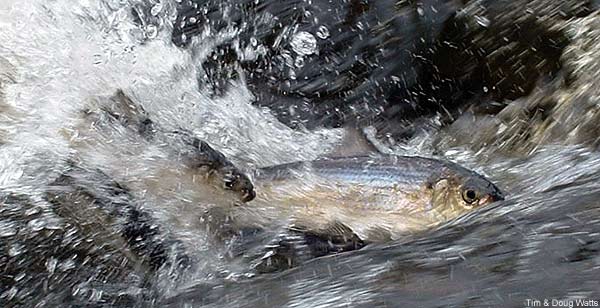Recently we’ve heard a lot of trumped up talk about building walls. While we don’t get political here at The Fisheries Blog, we wanted to take this opportunity to highlight the trend of taking down walls, also known as dam removal.

Dams are built for a lot of good reasons. Larger ones produce hydropower, and many help with irrigation, flood control, and produce recreational opportunities, among other benefits. We’ve also built a lot of dams. According to American Rivers:
“The US Army Corps of Engineers has catalogued at least 80,000 dams greater than 6 feet along the waterways of the United States – and at least tens of thousands of smaller dams pepper our rivers and streams. Secretary of the Interior Bruce Babbitt recently observed that, “on average, we have constructed one dam every day since the signing of the Declaration of Independence.”’
Unfortunately, dams also come with costs, both economical and ecological. Ecologically, dams change streams, and not only where they obviously stop-up the water, but also downstream where they alter flows, temperature, and other important aspects of fish habitat. Despite all the benefits of dams, we have seen tremendous loss of habitat for many diadromous fishes that are not full-time stream species, but use the streams for the connectivity to other habitats.

Economically, while some dams generate money, others do not (or no longer do) and like other parts of our aging American infrastructure, require resources to maintain. Often, when dams are no longer useful or become too expensive to maintain and repair, they are removed. And dam condition and maintenance is not only an American issue—just in the past few days the alarm has been raised in Mosul, Iraq where the Mosul Dam holds the potential for “a humanitarian catastrophe of epic proportions.”
Although the number of active dams still far outweighs the number of dam removals, things have changed in recent years. Starting around 2000, dams began to be removed at a greater rate than they were being constructed. Partly, fewer dams are bring built, but stakeholders are also seeing the value in removing aged dams; over the last 5 years an average of 50-70 dams are removed per yer, many along the east coast (which is where some of the oldest dams are located).
Be sure to check out this fascinating timelapse video of the Elwha Dam being removed.

What makes a good candidate for dam removal? Are there priorities when it comes to choosing a dam for removal? I know without a doubt there are more dams over 6′ tall in Kansas on streams and rivers. Your map only shows one.
Paul, I think there are a lot of factors that go into whether a dam will be removed—like how functional it is, and who is paying for its maintenance and repair. Like anything else, dam removal is a cost–benefit calculation done on a case-by-case basis. Beyond that, I don’t have the expertise in dam removals to know the trends. The American Rivers website is a good source of information, and you might find it worth your time to check it out. Also, the map is showing dam removals, not existing dams, which is why the numbers are lower than you might expect.
Reblogged this on Adventures In Aquaculture.
Paul, the last blog response to your question about what makes a “good” dam removal relates to the benefits and services derived by the removal for public good versus the costs for removing. The benefits include reduced risk of downstream flooding, especially with dams designated/rated as “high hazard” by a state’s dam safety program. There are many other benefits, ecologically, such as restoration of fish populations that need river connectivity to provide healthy sustainable populations, and improved water quality upstream of the dam where impounded conditions often results in warmed waters with lower dissolved oxygen levels – in general, such conditions often limit use by (more) sensitive aquatic species. There are also recreational benefits to open rivers including free passage for canoeing and kayaking (less dams means less portages). Aesthetic values and riverine fishing opportunities are often derived by restoring free-flowing rivers. On the flip side, the dam owner must be in support of the dam removal, and optimally has funds to financially support the work. There are costs for removing the structure plus the potential requirement of removing impoundment sediments, particularly if contaminant sediments are present that if released, would cause significant human health and/or ecological risk. These various factors are typically brought to the public discussion level early on through the completion of a feasibility analysis, often completed by experts in both engineering and environmental sciences. If you are interested, there are a number of publications available to cover this broad-reaching, inter-disciplinary topic.
To see time lapse photos and some video of the latest and largest dam removal in California, go to:
http://www.sanclementedamremoval.org
Videos are at:
http://www.sanclementedamremoval.org/?page_id=1570
Time lapse photos form three cameras [tabs] where you can choose a specific date off the calendar over the last three years to review what was happening:
http://www.sanclementedamremoval.org/?page_id=91
To quote “80,000 dams greater than 6 feet along the waterways of the United States – and at least tens of thousands of smaller dams pepper our rivers and streams”
Thats absolutely crazy numbers – its hard to imagine that many dams exist.
@Kevan Urquhart – The San Clemente Dam Removal videos are brilliant, so good to see Rivers being restored
James